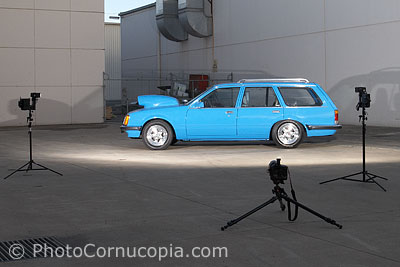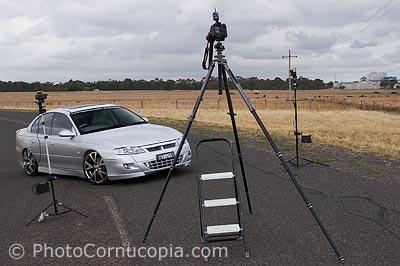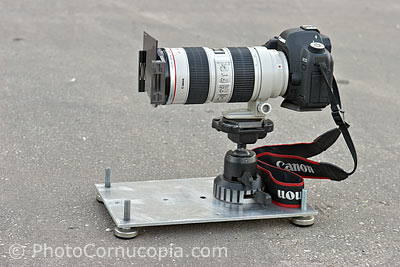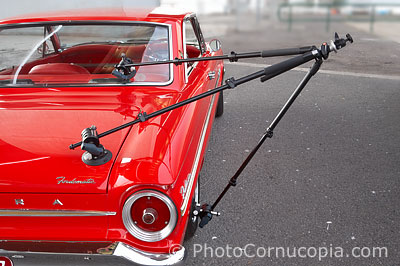|
Topic: |
Automotive
Photography 2:
Equipment primer |
|
Author/Copyright: |
John Jovic |
The equipment you use wont take
the photo's for you, however, it is important to have equipment that
doesn't hamper your efforts either. The best approach is to use the gear
that you already have and if you find it has limitations then look into
upgrading that part of the equipment.
The creativity you bring to a shoot is more important than your choice
of equipment so don't get too hung up about it.
Which camera?
The table below briefly compares some of the different types of cameras
commonly available today. There are so many different models in almost
every category that there will always be exceptions in each category so
it's not reasonable to go into too much detail.
|
|
Advantages |
Disadvantages |
|
Point and Shoot |
- Cheap (often)
- Small/Compact
- Easy to use
- No need to focus
|
- Difficult to use filters such as
ND grads and Polarsing filters
- Limited lens choice if any
- May not offer RAW files
- Significant shutter release delays
- May not allow full manual control,
including focus
- Poor high ISO noise performance
|
|
4/3, MFT, APS-C and similar Electronic
View Finder (EVF) cameras |
-
Small/Compact
- Interchangeable lenses, including
many Alternative or Legacy lenses (ie non OEM) with the use of
adapters
|
- Similar disadvantages to Point and
Shoot except that they have interchangeable lenses however many of
these cameras have features very similar to DSLR's
|
Crop Cameras (DSLR)
APS-C/H (Canon
APS-C (Nikon)
|
- Fast frame rate, often due to
having a smaller file size
- Larger/faster buffer than most
full frame cameras
- Option to use many Alternative or
Legacy lenses (ie non OEM) with the use of adapters
|
- No major disadvantages except that
the sensor sizes makes it harder to achieve a very shallow depth of
field than a larger sensor, but this can be seen as an advantage
too.
- Can be inexpensive
- May need dedicated lenses to
achieve a wide angle of view, such as Canon EF-S lenses, which can
not be used on full frame bodies
|
Full Frame (DSLR)
(35mmx24mm sensor) |
- Large file size
- Excellent high ISO noise
performance
- The larger sensor allows a
shallower depth of field than crop cameras so offers slightly more
creative control
- Large choice of lenses
- The full frame body is usually the
'flagship' camera for each brand so they are normally a 'pro' body
with all the bells and whistles (features) that professionals need
so are the most flexible in their use
- Option to use many Alternative or
Legacy lenses (ie non OEM) with the use of adapters
|
- Expensive
- Can be heavy/large
- Slow frame rate, not suited to
sport or action photography where a high frame rate is needed
|
|
Medium format |
- The larger sensor allows a
shallower depth of field than full frame cameras so offers slightly
more creative control
- The sensors don't have Anti
Aliasing (AA) filters which reduce sharpness on Full Frame and Crop
cameras, however this can cause Moire.
|
- Very expensive
- Limited selection of lenses
- Generally large, heavy and
cumbersome to use
- Slow frame rate, not suited to
sport or action photography where a high frame rate is needed
|
The single most important
point when choosing a camera is that you should be able to have full
manual control of the camera and lens, and you should know how to use
them. Many point and shoot cameras don't allow this so level of manual
control so are best avoided for this reason alone, but some are just
fine.
The end use for the images will drive your camera choice as will the
subject matter itself. For example, even a 6 mega pixel camera is fine
for web use, if that's all you want to do, but the camera may limit the
size of any prints made from it. If large prints are needed than this
might be a valid reason to upgrade to a camera with a larger file size
(not necessarily a physically large sensor).
If you are shooting motorsport or action such as panning or tracking
shots then a high frame rate, usually faster than 5 frames per second,
or a large buffer will allow you to shoot more frames without having to
wait for the camera to process and save the images to a card. It's not
that you always need a camera that will shoot 10 frames per second,
although that can also have it's uses, but a camera which forces you to
stop shooting because it hasn't processed it's data is a major nuisances
and should be avoided. This type of photography is much easier with
certain crop cameras which have smaller files than full frame cameras
and can shoot and save the image to a card at a much faster rate (than
many full frame cameras).
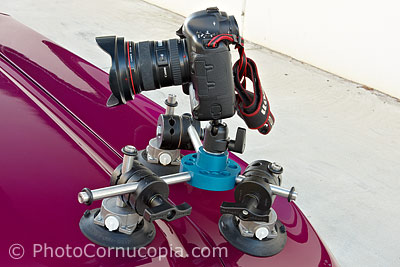 |
|
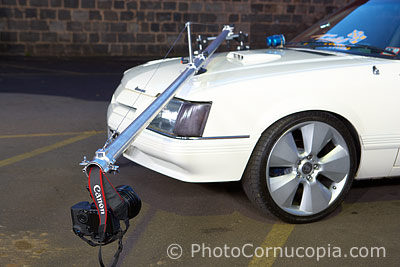 |
|
Using an expensive and heavy Full Frame camera for
a rig shot isn't necessary when a Crop camera would be lighter,
cheaper and often have a faster buffer too. |
|
Crop cameras are often
lighter than Full Frame cameras so can be a better choice for that
reason alone. |
The decision to use a crop or full frame camera is a personal one
however full frame cameras have the advantage of offering a shallower
depth of field than crop cameras so can offer a level of creative
freedom that might be harder to achieve with crop cameras. This
advantage, shallow depth of field, increases with the size of the
sensor so medium format cameras have this advantage over full frame
cameras.
Lenses
The subject matter also determines the kinds of lenses used. Motorsport
demands the use of fast aperture and fast auto focus telephoto lenses,
because of the distance between the photographer and the subject, whilst
static car photography is much less demanding of lens choice.
The most efficient way to work is to use zoom lenses so most
professional car photographers use several zoom lenses, from very wide
to short/medium telephoto. Good quality lenses are far preferable to so
called 'kit' lenses. If expensive 'pro' zoom lenses are simply beyond
you budget then consider prime or fixed focal length lenses which are
usually much cheaper but generally offer very high image quality. The
advantage of a zoom lens is simply it's flexibility and speed of use but
this may not be an important factor for everyone.
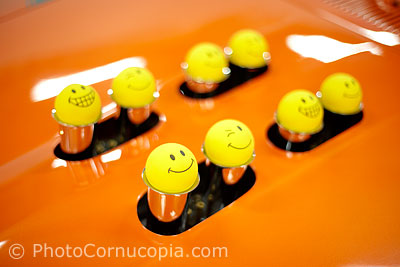 |
|
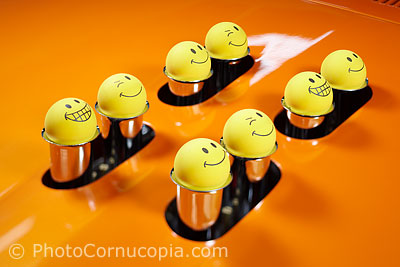 |
|
Shot at F1.4 with a 50mm lens. |
|
Shot at F2.8 with an
80mm Tilt lens adjusted so the focal plane was tilted at the same
angle as the subject. |
Specialised lenses can be
used for creative effect or simply to resolve technical issues like
controlling the focus plane. Very fast lenses can be used for their
shallow depth of field or possibly for their bokeh. Tilt/shift lenses
can also be very useful, particularly for detail shots, however they can
be expensive, slow and difficult to use.
Ultra wide angle lenses are required to shoot interiors. A typical
interior might be shot with a 16/17mm lens on a full frame body or a
10/12mm lens on a crop camera. Even wider lenses can be used for effect,
such as full frame fish eye lenses which give a much wider view of an
interior than is possible any other way.
Tripods and supports
The single most important and overlooked piece of automotive
photographic equipment is the tripod. If you don't have a good one then
get one. It is very important to hold a camera very still. Cheap, light,
flimsy tripods simply do not do this so should be avoided at all costs.
Don't buy cheap tripods, it will cost you more in the long run.
A high
quality tripod head with a quick release plate is essential if you want
to be able to detach and reattach the camera quickly. Ball heads
are very quick to use and potentially very rigid but they might take
some getting used to if you've never used one. Three way heads are also
excellent, but slower to use. If you have several tripods, for example
in varying heights/weights/ground level, then try to use the same tripod
heads on all of them as it's much easier to switch from one to the
other.
Lighting
Various forms of lighting will be discussed later so the approach that
you wish to take will ultimately dictate the lighting needed. You may
simply choose to use available light with no additional lighting at all
however this may severely limit your work to a narrow lighting style or
'look'.
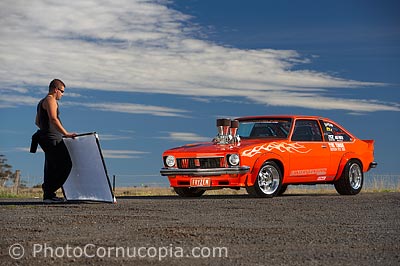 |
|
 |
|
A simple reflector can be very useful and
potentially faster to use than strobes however they are really only
useful on sunny days and in light winds. |
|
Battery powered
strobes are the mainstay of the automotive photographer but they can
be slow to setup and adjust. They offer the greatest amount of
flexibility and allow the photographer to create their own light and
even overpower sunlight if needed. |
As most
automotive photography is on location, and away from mains power,
battery powered strobes tend to be the preferred artificial lighting source.
Continuous lighting can also be used to light paint a car at night and
they can be either battery or mains powered.
Software
Shooting RAW offers the photographer far greater flexibility than
shooting jpegs although jpegs require far less post processing, if any,
so may be a better choice if the work is time critical. The RAW
converter you use will have an impact on how quickly and easily you
process RAW files. There are certainly many RAW converters on the market
and often the differences are minor however there certainly are
differences between them so it's a good idea to try various options and
see which one works best for you. Phase One Capture One is an excellent
option and offers many of the functions that where previously only
available in image manipulation software such as Photoshop. Image
manipulation software such as Photoshop will always be needed where
extensive manipulation is needed, such as compositing or cloning images.




